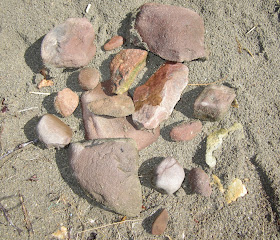How much do we know about Stonehenge? Less than we think. And what has Stonehenge got to do with the Ice Age? More than we might think. This blog is mostly devoted to the problems of where the Stonehenge bluestones came from, and how they got from their source areas to the monument. Now and then I will muse on related Stonehenge topics which have an Ice Age dimension...
Pages
▼
Friday, 28 August 2015
Red sandstone erratics at Newport
I went for a walk on the shoreline of the Nevern Estuary yesterday (while my car was failing its MOT test) and when I wandered across the exposures of till exposed between HWM and LWM I was once again amazed by the frequency of red sandstone erratic cobbles and pebbles.
The colouring varies from purple through red towards the pink end of the scale, and the rocks vary in texture too -- some are coarse and some are fine-grained. But I did not see anything resembling a true red marl. Some cobbles are more like gritstones than sandstones.
So where on earth have they come from? I doubt that they can be from any of the Old Red Sandstone outcrops in the UK, since there is no evidence (so far as I know) of ice movements from any of those areas towards North Pembrokeshire. The cobbles cannot have come from the red and purple Cambrian Sandstones of the St David's area either -- since that would have involved ice moving from the SW towards the NE.
So one has to assume that the sandstones are from the Lower Cambrian deposits around the Harlech Dome in North Wales -- maybe carried initially by Welsh ice flowing westwards of south-westwards from the Welsh Ice Cap, and then picked and transported southwards by the Irish sea Glacier. A nice little puzzle.....
Note added: With regard to the Harlech Dome rocks, they are the right age, but are they the right colour? Hmm -- as far as I can see from some investigations, there are no red sandstones in the sequence. More and more intriguing.

Perhaps there is the possibility that one of our fellow - Bloggers (semi - anonymous) may offer to analyse some of your specimens, with the possibility of confirming their provenance? I believe he might be willing to assist....when he is not writing book reviews....
ReplyDeleteAre you considering showing some of these sandstone erratics to a Geologist in the hope of determining their provenance?
ReplyDeleteDetailed sandstone provenance I hear is extraordinarily difficult. Usually done my magnetostatigraphy.
ReplyDeleteDrs Ixer and Turner were recently asked to look at some Oz ballast to determine if it was British ORS. Much determined effort later the answer, maybe.
They look ORS! Look in the Irish Sea perhaps any on IoM??
M
http://www.chrisjohnson.nl/Wales/West-wales/i-QtQHfhM/1/M/kim%20holiday%20in%20wales%20%20344-M.jpg
ReplyDeleteLots of colours for sandstone in this part of the world. This picture is from further south than Newport, but the coast is littered with beautiful stones.
One reason I doubt people from this part of the world were regular visitors to SH is the complete lack (I think) of these stones amongst the "debitage"
Well, I suppose Scotland or the Isle of Man are possibilities. There is after all a lot of erratic debris in Pembs that has come from Ailsa Craig in the Firth of Clyde. Those fragments are all very comminuted -- mostly found now as small pebbles on beaches. The sheer abundance of these reddish stones suggests another source closer to hand -- maybe beneath the sea somewhere? I'm pretty sure that are not ship's ballast. Fragments are embedded in till.
ReplyDeleteThere are Irish Sea geological maps.
ReplyDeleteTry BGS web site perhaps.
I agree if common and widespread then a near source seems likely.
Acritarchs.
The lower Palaeozoic sandstone debitage has been dated on/by them very recently.
M